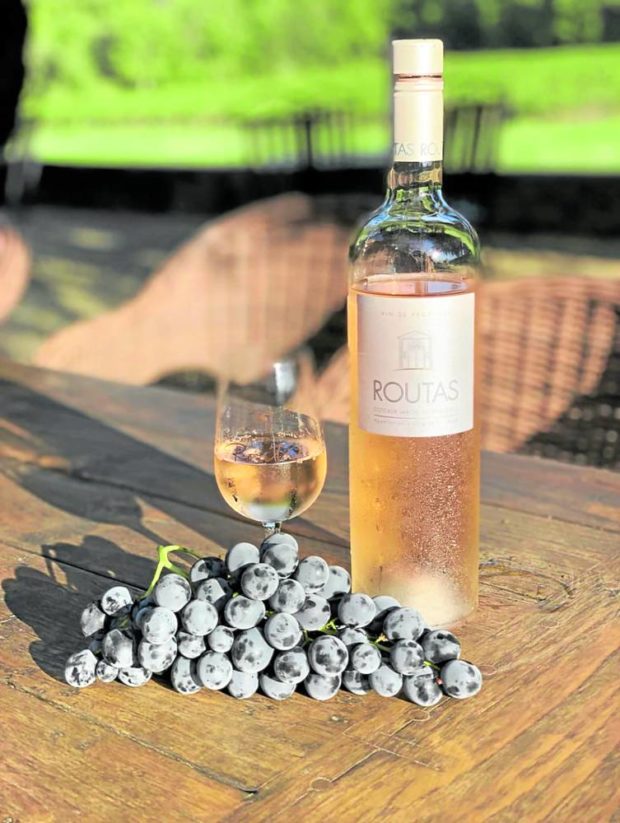
Summer is here and all I can think about is rosé! It’s the perfect time for that refreshing pink wine! Here’s the lowdown if you want to drink pink.
Rosé is a type of wine whose color is reflective of its name, neither white nor red but somewhere in between.
It’s a color achieved not by the grape variety used but by the process in which a wine gets its color. A wine’s color is achieved when the skin and juice of the grapes are soaked together, resulting in either a light yellow or red color. In the case of rosé, it is pink simply because it soaked for a shorter period of time, i.e., not long enough to turn into a red wine.
In fact, rosé can be made using any red grape and can be cultivated in any wine region: from Provence in France, known as the rosé capital of the world; to Spain, where it is called “rosado”; to Italy, where it is called “rosato”; to California, Australia, Argentina, etc. Usually it is made from a blend of a variety of grapes. Some of the common varieties used are sangiovese, syrah and pinot noir. In California, however, rosé is known to be a single varietal wine, using 100-percent pinot noir grapes.
Kinds of Rosé
Rosé is perfect for the summer because it resembles the flavor profile of a light red wine but with brighter and crisper tasting notes. Descriptors usually include the following flavors: strawberry, cherry, raspberry, citrus, melon and even celery.
Provence rosé
If you must randomly choose a rosé, you can’t go wrong with one from Provence. The region is known predominantly for its rosé, which accounts for nearly 75 percent of wine production. It is also home to Le Centre du Rose, or the Rosé Research Center, created in 1999 to become the world’s only research facility dedicated to rosé wine.
Provence produces the driest rosé in the world yet also considered the most versatile and classic of rosé wines, pairing well with any cuisine. It is also considered minerally and delicately fruity, with notes of strawberry and rose petal. They are made primarily from grenache grapes, which are often blended with syrah and cabernet sauvignon.
Cabernet sauvignon rosé
For something similar to red wine yet still summery, go for the cabernet sauvignon rosé, a darker rosé that tastes the most like red wine compared with other rosés. It is considered savory, with notes of bell pepper, black currant and spice, or even leather, tobacco and pepper. Yet it’s still perfect for the summer with its sweet and tangy profiles, making it acidic than regular cab sauv. This rosé is recommended to be appreciated with light seafood or vegetables.
Syrah rosé
It is actually not pink but dark red, as syrah is a very tannic grape. The result is a more hearty rosé. This is a bold wine with notes of olive and cherry. It has notes of plums, dried cherries, as well as hints of smoke and spice. This is the rosé to pair with your adobo as it is great with stews. It also does not need to be served cold, unlike the usual rosé.
Tempranillo rosé
For a taste of Spain, have a tempranillo rosé, which is often a Spanish variety. This is a little spicier than Provence rosé but still with refreshing berry tastes. Like Rioja, which is also made from tempranillo grapes, tempranillo rosé effuses a green pepper flavor while also exhibiting the same floral quality found in rosés from Provence. As it is both savory and fruity, it would also go well with meats, such as kaldereta and mechado.
Tavel rosé
Tavel is a region of the Rhône Valley dedicated to exclusively making rosé. Tavel rosé is an unusually dry rosé from mainly Grenache and Cinsault, though nine varieties are allowed in the blend. While it is pink, its color is very dark and intense, indicative of the powerful taste in the bottle that can stand up to meats and other strong flavors and textures. This is the rosé for red wine lovers as it is considered to have all the characteristics of a good red wine, just with less color. It is hearty, spicy and full of assertive tannins. Yet it has a nose of summer fruits that can turn to earthy, nutty notes over time. It is said to have been the favorite of writer Ernest Hemingway.
Pinot noir rosé
This is a delicate, crisp, pink wine made from 100-percent pinot noir grapes. These blush wines are characterized by crisp acidity, low sugar content, and delicious rose petal and strawberry flavors. This rosé shares a lot of the same fruit notes as Provence rosé, such as strawberries and melon, but is earthier and even described as seductive. It’s the perfect summer date wine!
Sangiovese rosé
This is a vibrant Italian wine that is fruity but dry. You will get notes of fresh strawberries, green melon, cranberries, raspberries and honeydew. It’s an easy wine that strikes a wonderful balance between dryness and fruit-forward flavor.
Other kinds of rosés include: White Zinfandel, which is a type of sweet rosé with moderately high acidity levels; Mourvedre rosé, which is a full-bodied rosé with initial floral notes that transform on the palate into a rich cherry and smoky flavor; and Rose Champagne, or sparkling rosé, which is Champagne blended with red wine (note that blending is frowned upon and Champagne is the only region in France where it is legal to blend white and red wines together to create rosé).
Whatever rosé you choose, you can definitely beat the heat with this summer treat. Keep it chill and drink pink! INQ

